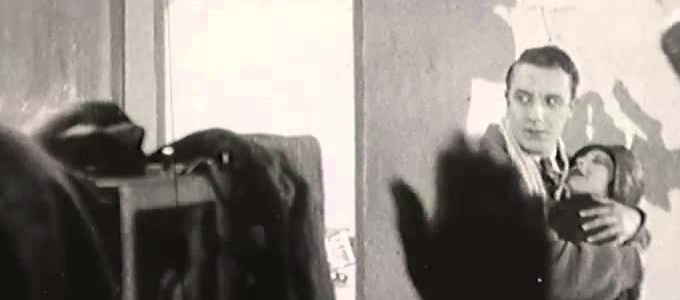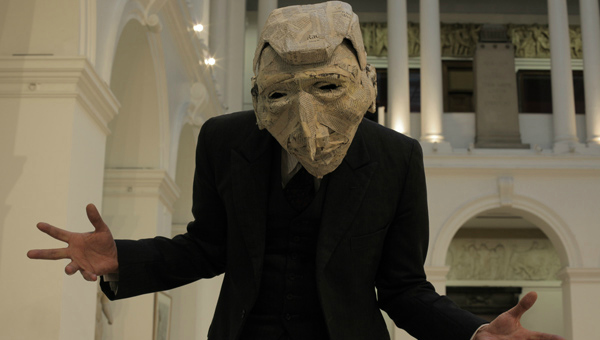
Bernard Natan revolutionised French cinema. So why was he destroyed, imprisoned, murdered, and then, after his death, why was his very memory turned into a sick joke? Toby Miller spoke to David Cairns about his film NATAN.
Toby Miller: The only major mention I could track down for Bernard Natan was via your Shadowplay blog , in a footnote to an article on early French film. Was that mention the catalyst for the documentary, and what role did your co-director Paul Duane play in seeing the bigger story behind these little tiny bits of information?
David Cairns: It began with an ex-student of mine mentioning he’d stumbled upon this interesting story of a man who had simultaneously run a major French film company in the ‘20s whilst also embarking on a career in pornography. I looked at the same sources as he had looked at and wrote a little blog on Shadowplay, which I’ve subsequently removed as everything in it was wrong; it turned out that almost everything said about Bernard Natan for years has largely been nonsense, or misinformation, or, at the very least, distortion. But my initial post did make Paul Duane get in touch. He thought the story, whilst interesting, seemed incorrect, it didn’t seem possible that anybody could be running a major studio and having a sideline in porn – as he put it, “Who would have the energy?”
Paul dug a little bit deeper and found other sources which gave a slightly clearer picture of this story, which in turn led him to think there could be a film in uncovering the true story. Luckily for us the Irish Arts Council then offered to back the film, which after all was going to be a 60 year old story about a Frenchman forgotten in his own country. And then we had to find out really what the story really was, because the research hadn’t really been done; we only knew a very small amount, so we embarked on discovering what the heck this story really meant.
TM: At the beginning of the production you said you didn’t trust the story that he was a media mogul by day, and that at night he produced pornography. Did you have any idea of the Pandora’s Box Natan’s story would open, both the scope of cinematic invention he was actually responsible for and the larger story of early 20th century prejudices and biases?
DC: Natan’s accomplishments have been completely erased, and anything you found about him on the first couple of pages of a Google search would be that he was a fraudster, a pornographer, that he had sex with a duck on camera; things that proved to be untrue. The tales about him being a pornographer seemed to be based on a tiny little misdeed early in his life, and when it comes to possible financial wrongdoing there is certainly room for doubt. But he hasn’t been given the benefit of the doubt at any point since 1938; rather, he’s been regarded as guilty of whatever you accuse him of.
But at the beginning Paul and I didn’t know a lot of this. We knew his ultimate fate at Auschwitz, so we knew there was a tragedy in here and we just didn’t know what led to it. We certainly had no inkling of how important a figure he was at that time; we hadn’t seen the films, and we hadn’t read up on the backstory and the various innovations and the breakthroughs that he made as head of Pathé. As we found out more, we discovered how important he genuinely was: he played a major role in pulling French cinema into the talking picture era. He also was vital in the development of Cinemascope and discovered important figures like Jean Gabin and Jacques Tourneur. I think going into the story one old theory we had seized on was that there were two Bernard Natans: one a legitimate film producer and the other a pornographer. But no, that didn’t make any sense, because as we quickly realised you couldn’t be a famous pornographer in the ‘20s and ‘30s because it was illegal – if you were famous for it you would be in jail.
So somehow this criminal history had been attached to Bernard Natan but how that happened still had to be discovered. We researched further with the help of Christine Leteux, who works for Kevin Brownlow and is a tireless archive hound. It was scary for me because I’d never made a documentary, so I felt like we were embarking on a film where you don’t initially know what the story is. Kind of like making a fiction film without a script. Fortunately there turned out to be a really good story there. I’m too bashful to make enormous claims for the film, but I think the story of Bernard Natan we’re now telling is incredible, and we’re just the ones lucky enough to have found it.
“It’s part of the drama that this is a man who’s been deliberately trashed.”
TM: Was there a stage during production where you and Paul realised that there was so little information available on Natan, that you were actually making a film that might be looked upon as an academic resource – and was that something that you balked at? I’m specifically wondering if the finished film’s abstract collage technique was a way of taking some of that weight off your shoulders?
DC: I don’t know. We were aware that there was going to be a shortage of visual material to illustrate Natan’s life and we would need to be experimental and creative to find solutions to that. In a way, it’s quite a good problem to have because it forces you to do something surprising. You can’t just show “Here’s the film of him doing this,” and “Here’s the record of him doing that”; sometimes you have to find more elliptical ways of addressing it. At one point we discovered that the films Natan produced illustrate his life beautifully, and you could make an entire movie of his life just using clips from those: people are sent to jail quite frequently in his movies, and one character gets shipped off in a prison train. There is a character who works as a projectionist. All the things that Natan did in his life worked their way into his movies. Whilst the clips weren’t conscious autobiography on Natan’s part, they seemed a perfect solution. But then we realised we couldn’t afford all of the clips, so it was back to thinking of a more creative solution, which is not necessarily a bad thing as long as you’re allowed a free hand to arrive at a method that you logistically can do. In our case the Irish Arts Council left us alone to make the film that we wanted to make, a unique set of circumstances that set us free to make the film as we thought it should be made, or course within the limits of our budget.
TM: But there must have been more to your visual approach. You’ve written in your blog about a fascination in the disintegration of the nitrate film stock, that Decasia look of melting reality. That, plus the slow chamber music you’ve used in the film remind me of the hauntology genre of music, where memories are unreliable and unsteady. Were these techniques partly to suggest the layers of Natan’s life? After all, he’d already changed his name to “Bernard Natan” to help distract from his Jewish heritage. That’s decades before the troubles began.
DC: Certainly we’d been thinking in terms of decomposing film very early on as something that would be handy here as we were dealing with a story where there were a lot of lies that had been told, and where those lies were an integral part of the story. Of course we wanted to tell the truth, but that couldn’t be done without addressing the lies, because it’s part of the drama that this is a man who’s been deliberately trashed. Because the character assassination began before the German occupation of France, Natan wasn’t seen as a victim of Nazi propaganda and so the lies were never corrected. So yes, we thought the film’s visual style was hopefully a good way of illustrating stories that in fact never occurred. We had to have an unreliable narrator or a film where we don’t really have a voice of authority, we just present different versions of what people have suggested happened and let the audience work out a version of the truth for themselves. And it also helped to create a fake Bernard Natan out of paper mache, a puppet figure with an actor wearing a false head in front of a rear projection screen showing footage of old Paris – that really makes the audience distrust the images that they’re seeing. All the deliberate artificiality means you’re not going to believe that this is a recreation of something that definitely happened, because it certainly doesn’t look like anything real.

TM: It’s also a throwback to the techniques of the time, with the rear projection, so it strangely blends with the story while also standing out as a documentary technique.
DC: And we also discovered that Natan was a pioneer in rear projection, though we didn’t find a place to actually say so in the film. Together with a man called Fernez-Le Prieur – who was also a pioneer of scuba diving – he took a new translucent screen technology to Hollywood, offering it to anybody to use free of charge. That was an exciting discovery and it certainly seemed apt to be using his techniques to tell his story, even though there wasn’t really a place in the film to brag about Natan’s relationship to rear projection.
TM: Which brings me on nicely to my next question. You went into production with only slanders, whispers and hearsays, and by the end you had a first cut of almost three hours. How did you sharpen that story, and why did you settle on a running time of 66 minutes?
DC: Yes, it’s an odd thing to do, isn’t it? The three-hour cut was never really a cut in a sense; our editor made a working draft with all of our interviews. It turned out to be story to be told fairly chronologically, it was such an unfamiliar story you would confuse people if you stepped out of the running order of what really happened. And by the time we found a structure for the film that worked, it was an hour long and we’d run out of time to edit it; it was a question of finishing it quite rapidly and then we were able to buy a little bit more editing time to do a good job of it. We’re quite happy with how it turned out in terms of as clear a telling of this complicated story as could be hoped for.
“If the film introduces the element of doubt into Natan’s life story that would at least be an accomplishment …”
TM: Rather than simply a story about a forgotten filmmaker, you found yourself with a complex tale of corruption, business jealousy, petty crimes that were blown out of proportion, gang mentality amongst the French press and anti-semitism. How did you make sure your film focused on the right things?
DC: Paul and I made sure all the film’s details were to do with Natan’s story, whilst all the surrounding great “movements of nations” stuff – the history of the 20th century – was as crude and simple as we could make it, otherwise the film risked being boring to those who already knew about the French occupation and perplexing to those who didn’t. I suppose most of what’s in the finished documentary has appeared in print in one source or another, but it’s rarely been gathered all together. Plus we did find a few little bits that were entirely new. It’s very good to tell this story in a film because a lot of the most powerful and dramatic material is newsreel archives and the films that Natan made; his granddaughters said to us early on that they were very pleased that this story was going to be told in the form of a film because their grandfather loved films, that was a really touching and empowering thing to be told as we embarked on this, that we were making something that there was a chance that Bernard Natan would have approved of made it more real somehow; we weren’t just making a project that might do your own reputation some good but you’re making the film for the subject, for the man himself.
TM: What has been the response to your documentary in France?
DC: We’re soon to get our first French screening so we can answer that then. It will be really interesting to see what the French response is, other than people who are already in the film and know about it: Natan’s granddaughters were very happy with the film (thank god) and some of the participants in the film have been very complimentary. I don’t think there’s going to be a resistance to this story there, I would hope not, but yeah, I’m fascinated to see it. We’re two outsiders blundering into a French story in hopes of getting enough of it right that it won’t be an embarrassment. I think it’s accurate enough that any mistakes we’ve made can be overlooked because the story is important enough and the story – we’ve managed to tell the story, and I think people should respond to that. If the film introduces the element of doubt into Natan’s life story that would at least be an accomplishment because we don’t have enough information to condemn this man and I think he’s been condemned enough. We do have a lot of information about his positive achievements, which are astonishing.
TM: Throughout the various Shadowplay articles you wrote during production you kept referring to NATAN as a working title, but yet you never got around to changing it…
DC: We certainly wracked our brains to think of other titles. The problem of making a film about a character who’s so forgotten that naming the film after him on the one hand it’s a defiant act – we’re saying “This man should be remembered, and here’s who he was”, but on the other hand how do you get people in to see the movie with such an oblique title? He’s got a great name because it’s a palindrome and it looks very good printed, so that was always an attraction. Also he used to sign his films and so the idea of giving him back his name all seems of value. But all the confusion did lead to something in the film which I’m quite pleased about: we have a narrator who’s speaking as Natan but he says “I am the film Natan, not the man Natan,” and that’s our way of sidestepping the issue of credibility. You’re going to be told a story by a film, which we hope is true, and it also contains some lies that have been told, and it will be up to you to decide; we don’t really have an authoritative voice anywhere in the film, which is probably the best way to tell this story, because it does deal with things that are still mysterious and may never be known but it is clear where it needs to be clear (I hope) and it is clear in the emotion it seems, because the reaction of people who have seen it has been quite emotional.
This interview took place at the Cambridge Film Festival in 2013.
Natan – Trailer from screenworksfilmandtv on Vimeo.

